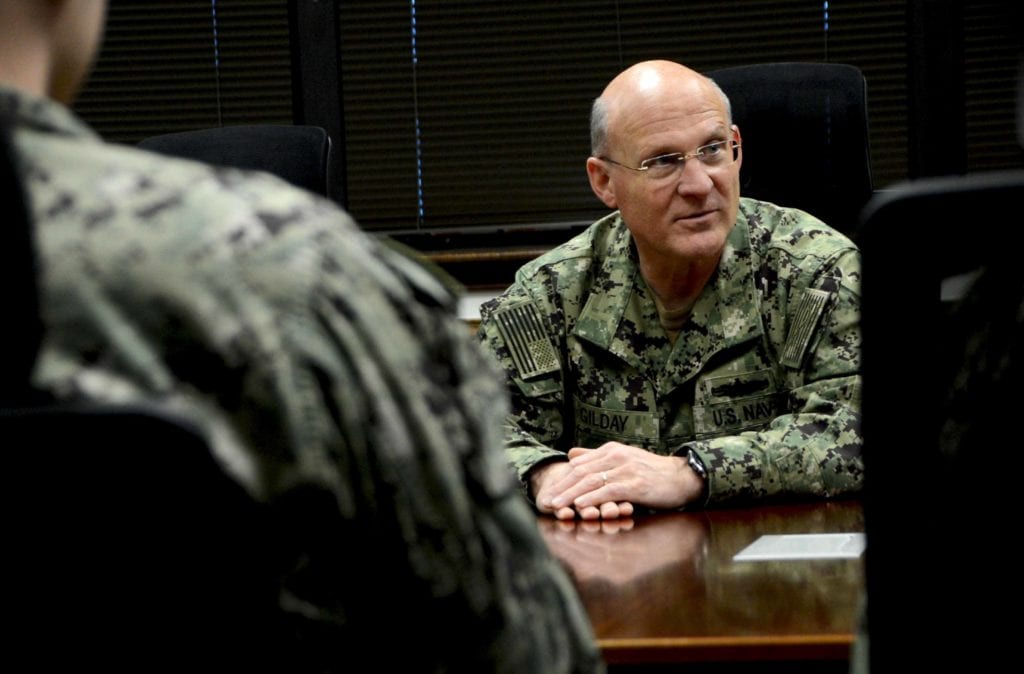
ARLINGTON, Va. — The chief of naval operations (CNO) said President Trump last week signed off on the secretary of the Navy’s proposed re-designation of U.S. Fleet Forces Command as the U.S. Atlantic Fleet. A timetable for the change has not been announced, but Fleet Forces Commander Adm. John Grady is proceeding with implementation.
Speaking Jan. 11 in a webinar of the Surface Navy Association convention, CNO Adm. Michael Gilday discussed the pros of the redesignation.
“It underscores the importance of the Atlantic in a way that the title ‘Fleet Forces’ doesn’t,” Gilday said. “It actually is a testament to recent tangible decisions that we made to increase our power in that body of water, to include bringing Second Fleet back, standing up SubGru 2 (Submarine Group Two). It will also include standing up [NATO’s] Joint Force Command Norfolk, which is focused on the Atlantic.”
Gilday said, “in a day and age when the homeland is no longer a sanctuary, and homeland defense is at the fore of every plan the combatant commanders have put together, the name ‘Atlantic Fleet’ always carries some gravitas with respect to defense of the nation.”
He noted the complexity of the re-designation, saying the command “also has responsibilities as a component [command] for [U.S.] Northern Command and the Eastern Pacific that extend up to the Arctic as well as their role as component of the [U.S] Strategic Command. They really have a global responsibility with respect to the command and control of our SSBNs [ballistic-missile submarines].”
Grady seconded the complexity in a Jan. 13 webinar at the convention, noting the “downside “might be that we would lose emphasis on what we do for the homeland. Indeed, I control forces in both the Pacific and down south [in U.S. Southern Command area of responsibility].
“So, we will balance all that, and in the end the name change is an important branding opportunity, and we will move out on that,” Grady said.
“We are walking through this very methodically and deliberately before we finally execute,” Gilday said.
The re-designation plan originally was announced by Navy Secretary Kenneth J. Braithwaite, testifying Dec. 2 before the Readiness and Management Support subcommittee of the Senate Armed Services Committee, noting that the changing world requires that the Navy must evolve to meet the threat.
“Our existing structure operates on the premise that we still live in a post-9/11 state, where NATO’s flanks are secure, the Russian Fleet is tied to the pier, and terrorism is our biggest problem,” Braithwaite said. “That is not the world of today. As the world changes, we must be bold, evolved, and change with it. Instead of perpetuating a structure designed to support Joint Forces Command, we are aligning to today’s threat.
“To meet the maritime challenges of the Atlantic Theater, we will rename Fleet Forces Command as the U.S. Atlantic Fleet and will refocus our naval forces in this important region on their original mission, to controlling the maritime approaches to the United States and those of our allies,” he said. “The Atlantic Fleet will confront the re-assertive Russian navy, which has been deploying closer and closer to our East Coast with a tailored maritime presence, capability and lethality.”
The U.S. Atlantic Fleet commander will have two numbered fleets assigned, U.S. Second Fleet, headquartered in Norfolk, Virginia, and U.S. Fourth Fleet, headquartered in Mayport, Florida. The U.S Second Fleet was reestablished in August 2018 to confront the increasing Russian activity.






